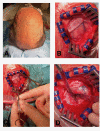Primary intraventricular haemorrhage: the role of frontal minicraniotomy and external ventricular drainage
- PMID: 33563669
- PMCID: PMC7875280
- DOI: 10.1136/bcr-2020-239448
Primary intraventricular haemorrhage: the role of frontal minicraniotomy and external ventricular drainage
Abstract
Primary intraventricular haemorrhage (PIVH) is an uncommon type of intracerebral haemorrhage, accounting for only 0.31% of all strokes and 3.1% of all intracerebral haemorrhages. Due to the low incidence of PIVH, little is known about its clinical characteristics, risk factors, aetiologies, prognosis and treatment. Acute hydrocephalus is common and is associated with a poor prognosis. External ventricular drainage (EVD) could promptly reduce intracranial pressure by diverting cerebrospinal fluid and intraventricular blood; however, the incidence of complications such as central nervous system infection, catheter occlusion and rebleeding are relatively common. Despite being an invasive procedure, frontal minicraniotomy is an available therapeutic option to avoid complications of EVD. The authors report a case of a PIVH managed with frontal minicraniotomy and perform a literature review about epidemiological data, clinical features and treatment of PIVH.
Keywords: coma and raised intracranial pressure; hydrocephalus.
© BMJ Publishing Group Limited 2021. No commercial re-use. See rights and permissions. Published by BMJ.
Conflict of interest statement
Competing interests: None declared.
Figures




Similar articles
-
Is external ventricular drainage useful in primary intraventricular hemorrhages?Adv Ther. 2005 Sep-Oct;22(5):447-52. doi: 10.1007/BF02849864. Adv Ther. 2005. PMID: 16418153
-
Application of the Ommaya Reservoir in Managing Ventricular Hemorrhage.World Neurosurg. 2016 May;89:93-100. doi: 10.1016/j.wneu.2015.12.040. Epub 2015 Dec 25. World Neurosurg. 2016. PMID: 26724628 Clinical Trial.
-
Transcortical approach surgery versus external ventricular drainage in treating intraventricular hemorrhage.Medicine (Baltimore). 2021 Oct 22;100(42):e27443. doi: 10.1097/MD.0000000000027443. Medicine (Baltimore). 2021. PMID: 34678873 Free PMC article.
-
Non-vascular structural-related intraventricular hemorrhage: Epidemiology and literature review.Clin Neurol Neurosurg. 2025 Feb;249:108700. doi: 10.1016/j.clineuro.2024.108700. Epub 2024 Dec 24. Clin Neurol Neurosurg. 2025. PMID: 39724807
-
Management of non-traumatic intraventricular hemorrhage.Neurosurg Rev. 2012 Oct;35(4):485-94; discussion 494-5. doi: 10.1007/s10143-012-0399-9. Epub 2012 Jun 26. Neurosurg Rev. 2012. PMID: 22732889 Review.
References
-
- Sanders E A study of primary, immediate, or direct hemorrhage into the ventricles of the brain. Am J Med Sci 1881;82:85–128. 10.1097/00000441-188107000-00008 - DOI
-
- Morgenstern LB, Hemphill JC, Anderson C, et al. . Guidelines for the management of spontaneous intracerebral hemorrhage: a guideline for healthcare professionals from the American heart Association/American stroke association. Stroke 2010;41:2108–29. 10.1161/STR.0b013e3181ec611b - DOI - PMC - PubMed
Publication types
MeSH terms
LinkOut - more resources
Full Text Sources
Other Literature Sources
